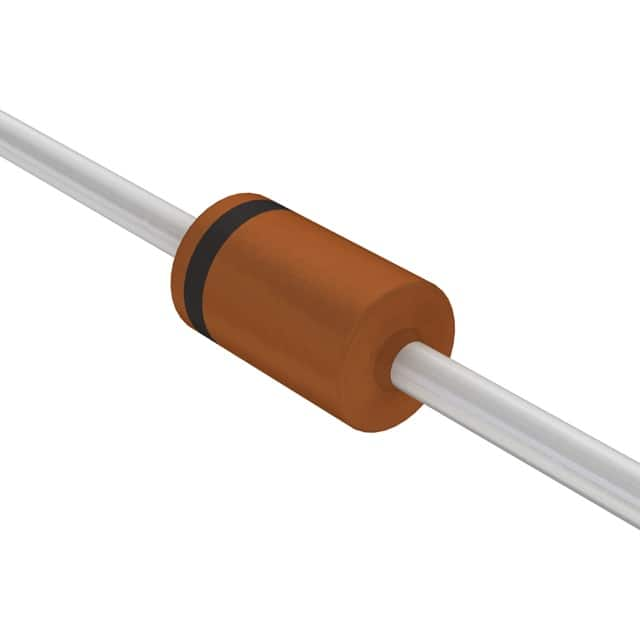1N4733A,133 - Semiconductor Diode
Basic Information Overview
- Category: Semiconductor diode
- Use: Voltage regulation and rectification
- Characteristics: Zener diode, low reverse leakage current, precise voltage regulation
- Package: Axial lead, DO-41
- Essence: Regulating voltage in electronic circuits
- Packaging/Quantity: Bulk packaging, 1000 units per pack
Specifications
- Voltage: 5.1V
- Power Dissipation: 1W
- Operating Temperature: -65°C to +200°C
- Forward Voltage: 1.2V
- Reverse Current: 5μA
Detailed Pin Configuration
The 1N4733A,133 has two leads, with the cathode marked by a band on the body of the diode.
Functional Features
- Precise voltage regulation
- Low reverse leakage current
- High reliability and stability
Advantages and Disadvantages
Advantages: - Accurate voltage regulation - Low reverse leakage current - Reliable performance
Disadvantages: - Limited power dissipation capability - Sensitivity to temperature variations
Working Principles
The 1N4733A,133 operates based on the Zener effect, where it maintains a constant voltage across its terminals when reverse-biased.
Detailed Application Field Plans
This diode is commonly used in voltage regulation circuits, overvoltage protection, and as a voltage reference in various electronic devices.
Detailed and Complete Alternative Models
- 1N4728A,133 (3.3V)
- 1N4729A,133 (3.6V)
- 1N4730A,133 (3.9V)
- 1N4731A,133 (4.3V)
- 1N4732A,133 (4.7V)
This completes the entry for the 1N4733A,133 semiconductor diode, covering its basic information, specifications, pin configuration, functional features, advantages and disadvantages, working principles, application field plans, and alternative models.
Lista 10 Vanliga frågor och svar relaterade till tillämpningen av 1N4733A,133 i tekniska lösningar
What is the 1N4733A,133 diode used for?
- The 1N4733A,133 is a Zener diode commonly used for voltage regulation and protection in electronic circuits.
What is the voltage rating of the 1N4733A,133 diode?
- The 1N4733A,133 has a nominal voltage of 5.1V, making it suitable for applications requiring a stable 5.1V reference voltage.
How does the 1N4733A,133 diode regulate voltage?
- The 1N4733A,133 operates in the reverse-biased breakdown region, maintaining a constant voltage drop across its terminals, effectively regulating the output voltage.
Can the 1N4733A,133 be used for overvoltage protection?
- Yes, the 1N4733A,133 can be employed to protect sensitive components from overvoltage conditions by shunting excess voltage to ground.
What are the typical applications of the 1N4733A,133 diode?
- Common applications include voltage regulators, voltage references, overvoltage protection circuits, and as a stable voltage source for biasing other components.
What is the maximum power dissipation of the 1N4733A,133 diode?
- The 1N4733A,133 has a maximum power dissipation of 1.3W, allowing it to handle moderate power levels in circuit designs.
Is the 1N4733A,133 suitable for low-current applications?
- Yes, the 1N4733A,133 can operate at low currents, making it versatile for various electronic designs.
What is the temperature coefficient of the 1N4733A,133 diode?
- The temperature coefficient is typically around -2mV/°C, indicating relatively stable performance over a range of temperatures.
Can multiple 1N4733A,133 diodes be connected in series or parallel?
- Yes, multiple diodes can be connected in series to create higher voltage references or in parallel to increase current-handling capability.
Are there any special considerations when using the 1N4733A,133 diode in a circuit?
- It's important to ensure proper heat sinking if the diode is operating near its maximum power dissipation, and to adhere to the manufacturer's recommended operating conditions for optimal performance and reliability.


